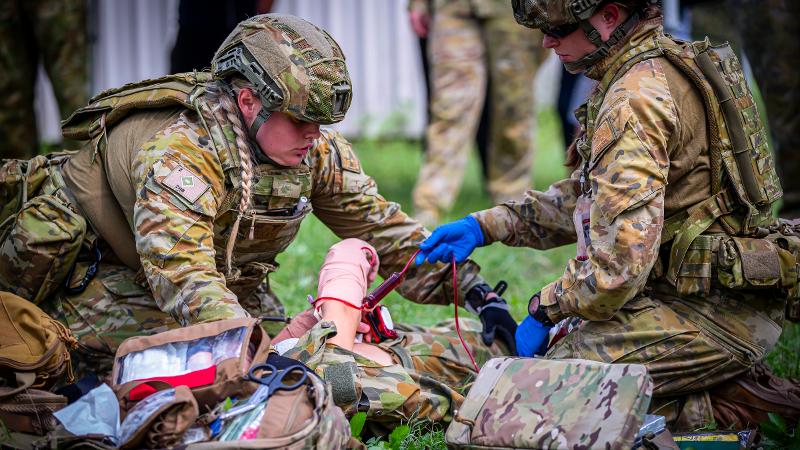
Among simulated casualties covered in blood and screaming in pain were paramedic students from QUT, who volunteered their time and bodies to help train Army medics during a major combat health exercise at the Greenbank training area.
Exercise Viper Walk involved more than 400 health professionals from the Australian Army’s 2nd Health Brigade, Royal Australian Air Force, New Zealand Defence Force and the United States military from March 4-18.
The art of moulage was applied by make-up artists within the 2nd Health Battalion, who diligently applied fake blood to wounds created from modelling wax.
Second year QUT paramedic student Emma Nikotemo jumped at the chance to role-play, having a simulated gunshot wound and compound fracture.
“The medics showed great care and communication and were very thorough with their checks. That’s something I’m taking away with me,” Emma said.
Dr Wayne Loudon, discipline lead for paramedic sciences in QUT’s School of Clinical Sciences, said the opportunity for Emma and other students was invaluable to their ‘real-world’ learning.
“The partnership between QUT and the 2nd Health Battalion offers exposure to high fidelity trauma simulation opportunities for students, led by experienced clinicians,” Dr Loudon said.
“This collaboration not only enhances student learning but also provides development opportunities for defence clinicians, fostering mutual growth and expertise exchange.”
Throughout the exercise, observer mentors with high-level experience in the civilian clinical system were used to oversee clinical scenarios and provide mentorship and detailed feedback to the training audience.
They controlled the role-play, directing casualties to respond and act according to injury.
The mentors followed a casualty run sheet that provided patient observations to create realistic challenges for clinicians.
This included Army medic Corporal Jonathon Todd, a part-time soldier who works for the Queensland Ambulance Service.
“I’ve guided activities like this before, but this one is a lot higher fidelity with more complex patients and logistical aspects behind it, which is not frequently practised,” Corporal Todd said.
Mentors provided feedback and their own experiences to the exercising clinicians on alternative treatment pathways, competence of clinicians and enthusiasm levels.
Director of Clinical Services Lieutenant Colonel Julian Williams, an emergency doctor at Royal Brisbane Hospital - was briefed by observers each day.
He said the best way to test a health system was to expose people, procedures and equipment to high-fidelity simulations.
“The way to overcome simulation fatigue is to use the equipment – we’re opening real drugs, drawing them up in syringes; this all contributes to the realism of the simulations,” Lieutenant Colonel Williams said.
Image: QUT paramedic students at Exercise Viper Walk. Photo: Corporal Melina Young
Media contact:
Amanda Weaver, QUT Media, 07 3138 3151, amanda.weaver@qut.edu.au
After hours: 0407 585 901, media@qut.edu.au

